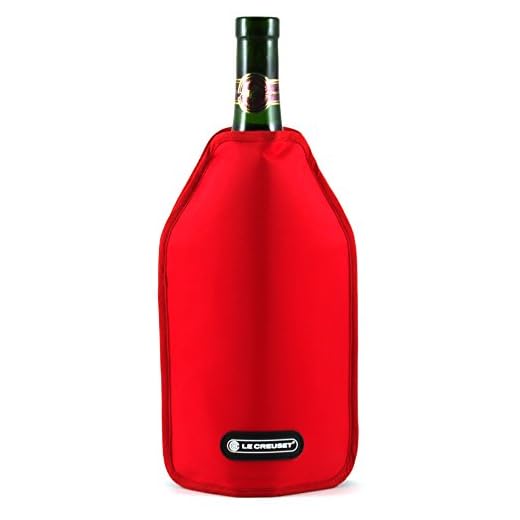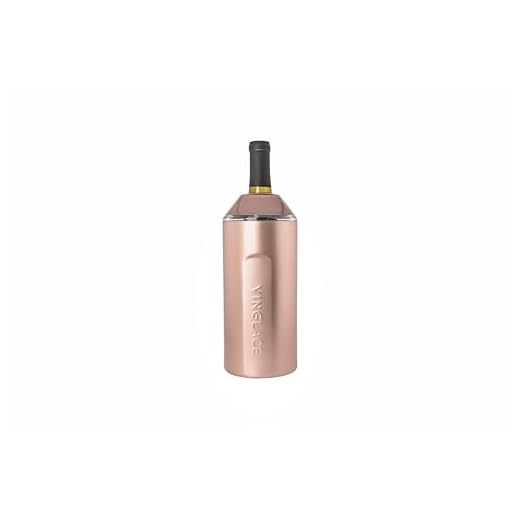



Serving this delightful beverage at a cool temperature, ideally between 45°F and 55°F (7°C to 13°C), enhances its refreshing qualities and vibrant flavors. A slight chill can elevate the experience, allowing the aromatic notes to shine while providing a crisp finish that complements various dishes.
When selecting the ideal temperature, consider the specific style of the beverage. Light and fruity variations benefit from being on the cooler end of the spectrum, whereas richer and more complex options can be served slightly warmer. This attention to detail ensures that each sip delivers the intended taste profile and aromatic nuances.
To achieve the perfect serving temperature, place the bottle in an ice bucket filled with equal parts ice and water for about 20 minutes. Alternatively, a short stint in the refrigerator for 30 to 45 minutes can also do the trick. Avoid excessive chilling, as it can mute the flavors and aromas, detracting from the overall enjoyment.
Optimal Temperature for Enjoying Pink Wine
Serving this delightful beverage at a temperature between 45°F and 55°F (7°C to 13°C) enhances its character and complexity. A cooler temperature accentuates the refreshing acidity and fruity notes, making it more appealing. Consider chilling it in the refrigerator for about 1.5 to 2 hours before serving. Alternatively, a 20-minute ice bath offers a quick solution if you’re short on time.
Avoid serving it too cold, as excessive chilling can mask the nuanced flavors and aromas. A warmer temperature allows the bouquet to open up, revealing the intricate layers that define its profile. Pay attention to the serving glass; a narrower bowl helps retain coolness while focusing the aromas towards the nose.
Experiment with different temperatures to find what suits your palate best. Tasting at various degrees can reveal how temperature influences the wine’s taste and overall experience. This process not only enriches your understanding but also enhances enjoyment during your next gathering.
Optimal Temperature Range for Serving Rosé
Serve this delightful beverage between 45°F and 55°F (7°C to 13°C). This temperature range enhances its refreshing and fruity characteristics while maintaining balance.
For optimal enjoyment, a precise approach is recommended. If the beverage is too cold, the flavors become muted, masking its complexity. Conversely, serving at higher temperatures can bring out unwanted sweetness and acidity.
Use a thermometer for accuracy, or employ the classic method of chilling in an ice bucket for 20 to 30 minutes. This technique ensures the ideal serving temperature without risking over-chilling.
Remember to consider the specific style; lighter versions may benefit from the cooler end of the spectrum, while richer, fuller-bodied varieties can be served slightly warmer. Adjust your approach based on the unique profile of each bottle.
Impact of Chilling on Flavor Profile of Rosé Wine
Chilling significantly enhances the aromatic and flavor experience of this type of beverage. A temperature drop can elevate the fruity and floral notes, making them more pronounced and enjoyable. The ideal range to serve this drink is between 45°F and 55°F (7°C to 13°C). This allows the delicate characteristics to shine without overwhelming the palate.
Flavor Changes at Different Temperatures
When served too warm, the alcohol can dominate, masking the subtleties of the drink. Conversely, excessive cooling might mute the flavor profile, leading to a flat experience. The balance is key. At the optimal serving temperature, one can expect the following flavor enhancements:
| Temperature (°F) | Flavor Characteristics |
|---|---|
| 45-50 | Bright acidity, pronounced fruitiness |
| 50-55 | Complex aromas, balanced mouthfeel |
| Above 55 | Overwhelming alcohol, muted flavors |
The perception of acidity and sweetness shifts with temperature. Cooler temperatures tend to enhance the crispness, making it an ideal companion for light dishes. Warmer temperatures can accentuate the richness, pairing well with more robust flavors. Understanding these dynamics allows for a more tailored tasting experience, ensuring enjoyment with every sip.
Best Methods for Chilling Rosé Quickly
To rapidly cool a bottle of pink nectar, consider using an ice-water bath. Fill a bucket or large bowl with equal parts ice and water, then submerge the bottle for approximately 15-20 minutes. This method ensures even cooling and is significantly more effective than ice alone.
Alternative Quick-Chilling Techniques
- Salt Addition: Adding salt to the ice-water bath can lower the freezing point of water, enhancing the chilling speed. Just a handful will do.
- Freezer Method: If time is limited, placing the bottle in the freezer for 10-15 minutes can yield quick results. Be cautious not to forget it, as prolonged exposure can lead to a frozen explosion.
- Chilling Sleeves: Invest in a gel-filled chilling sleeve. Pre-freeze it and wrap it around the bottle for effective cooling, usually within 30 minutes.
Bonus Tips for Optimal Results
- Surface Area: If you have a decanter, transfer the liquid into it. The increased surface area will facilitate faster temperature reduction.
- Pre-Chill Glassware: While you chill the bottle, consider placing your glasses in the freezer or filling them with ice water. This will enhance the overall drinking experience.
- Temperature Monitoring: Use a wine thermometer to ensure you reach the ideal serving temperature, usually between 45°F and 55°F (7°C to 13°C).
Common Misconceptions About Serving Temperature
Many believe that all light-bodied beverages should be served icy cold, but this isn’t always accurate. A common myth is that lowering the temperature excessively enhances the drink’s freshness and flavor. In reality, extreme cooling can mask the subtleties and complexities present in a well-crafted beverage.
Another misconception is that a specific temperature is universally ideal for all types of light wines. Each variety possesses unique characteristics that influence its optimal serving temperature. For example, while some prefer a crisp chill, others benefit from being served slightly warmer to reveal their full aromatic potential.
It’s also thought that chilling can only be achieved through ice buckets or refrigerators, but alternative methods exist. For instance, a quick soak in ice water can effectively lower the temperature without risking the dilution that can occur from ice cubes.
Some aficionados argue that chilling diminishes the perception of sweetness, which can be misleading. A well-balanced beverage will maintain its flavor profile regardless of slight temperature variations. For those interested in pairing, understanding these nuances can elevate the dining experience significantly, as exemplified in my guide on how to cook a beef tenderloin.
In conclusion, discerning the truth about serving temperatures can enhance appreciation for these delightful drinks. Knowledge and experience lead to better choices, allowing one to enjoy each sip as intended by the producer.
When to Serve Chilled vs. Room Temperature Rosé
Serving temperature plays a significant role in enhancing the flavors and aromas of your favorite pink beverage. For optimal enjoyment, a range of temperatures can be applied based on the specific occasion and personal preference.
Chilled Serving Recommendations
- On warm summer days or during outdoor gatherings, serving at a cooler temperature (45-50°F or 7-10°C) refreshes the palate and accentuates the crispness.
- Pairing with light appetizers, seafood, or salads benefits from the chill, as it balances the freshness of the food with the acidity of the beverage.
- For sweeter variations, a cooler temperature enhances the fruitiness, making it an ideal choice for casual sipping.
Room Temperature Scenarios
- In cooler months or paired with richer dishes like roasted meats, serving slightly warmer (50-55°F or 10-13°C) allows the complexities of the beverage to unfold.
- When tasting for educational purposes or exploring various flavor notes, a room temperature approach can reveal subtleties otherwise masked by cold.
- If the beverage has undergone significant aging, a warmer temperature can help express its full profile, showcasing the depth of flavor.
Ultimately, the choice between a chill or room temperature depends on the setting, food pairings, and personal taste. Experimenting with both can lead to a deeper appreciation of this delightful drink.
FAQ:
Should I chill rosé wine before serving?
Yes, chilling rosé wine is generally recommended. The optimal serving temperature for rosé is between 45°F and 55°F (7°C to 13°C). Chilling the wine enhances its refreshing qualities, making it more enjoyable, especially during warm weather or with lighter meals. You can chill it in the refrigerator for a couple of hours or use an ice bucket for a quicker option.
What are the benefits of serving chilled rosé wine?
Serving rosé wine chilled brings out its bright acidity and fruity flavors, which can be muted when the wine is too warm. Chilled rosé is often more refreshing, making it an ideal choice for outdoor gatherings, picnics, or summer barbecues. Additionally, a cooler temperature can help balance the wine’s sweetness, ensuring a more pleasant tasting experience.
Is there a specific temperature range for chilling rosé wine?
Yes, the ideal temperature range for chilled rosé wine is typically between 45°F and 55°F (7°C to 13°C). This range allows the wine’s flavors and aromas to be fully expressed while maintaining a refreshing character. If the wine is too cold, you may miss out on some of its nuances, while serving it too warm can overwhelm the palate.
Can I chill rosé wine in a hurry, and if so, how?
Absolutely! If you’re short on time, you can chill rosé wine quickly by placing the bottle in an ice bucket filled with equal parts ice and water for about 15-20 minutes. This method cools the wine rapidly and evenly. Alternatively, wrapping the bottle in a wet paper towel and placing it in the freezer for about 10-15 minutes can also work, but be sure to set a timer to avoid forgetting it!








